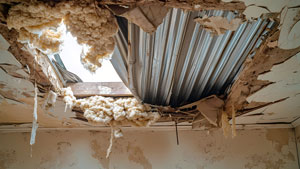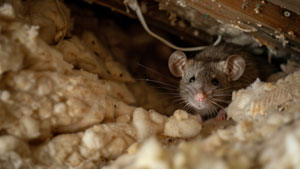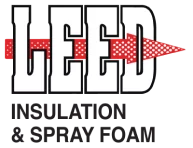In our hot and humid Florida climate, attic insulation plays a major role in keeping your home cool and energy efficient and safe from our extreme heat and moisture. When your insulation is working properly, your AC system runs more efficiently. But if your insulation gets damaged, especially by excessive moisture or pests, it can create serious problems fast. This blog breaks down the causes of damaged insulation, signs to look out for, and why quick action matters.
Common Causes of Damaged Insulation
Our weather and wildlife bring unique challenges to our attic spaces and the insulation installed up there. If your home’s insulation gets damaged, it could be caused by water, pests, or both.
Water Damage

The most common cause of moisture damage to insulation is roof leaks from our frequent rainstorms and hurricanes. Leaks may also come from your AC unit, especially if there’s pooling water or condensation around the handler.
When insulation gets soaked, it can begin to compact and lose its insulating power (called R-value). Worse, it could trigger mold growth, which can develop quickly in our humid conditions. Left untreated, mold may even reach your attic’s wooden roof joints and rafters, causing structural decay and water stains on your ceilings and walls.
Pest Infestation Problems

Your attic is also a magnet for pests. Rodents (such as rats, mice, and squirrels), insects, and even bats can enter through cracks or damaged shingles and declare your attic as their new home. Once inside, some pests may lay eggs, chew through your electrical wires, burrow tunnels in your insulation, and create nests. They leave behind nest materials, droppings, and urine, which compress and damage your insulation and make it unsafe.
This contamination can lead to serious health risks. Waste from pests carries diseases, and dead animals and waste can create foul odors too. Pests can also carry parasites like fleas into your home. These infestations may start in the attic but can easily spread to wall voids and living areas if not handled with proper pest control.
Warning Signs of Damaged Insulation
There are many indicators that your insulation may not be at its best. Here are some:
Visual Clues
- Black or green patches of mold or mildew (a sign of water damage)
- Clumpy or discolored insulation
- Shredded insulation bits
- Evidence of pests, such as animal droppings, nests or chewed materials
Sensory Clues
- Persistent musty smells
- Pungent odors from rodent waste
- Scurrying or scratching sounds at night
Performance Clues
- Unexpectedly rising utility bills
- Rooms that are too warm and don’t stay cool.
The Consequences of Ignoring Damaged Insulation
As with many things, we wish we could just forget about the problem and hope it goes away on its own. Unfortunately, that’s not a good idea with insulation. If your damaged insulation is left alone, the problems will only grow. Your energy bills can spike as your AC system struggles. Moisture can lead to rot in rafters, moisture buildup in drywall, and ceiling stains and damage. Mold spores can become airborne, triggering allergies and respiratory issues.
Rodent droppings are also a major health concern. They can carry Hantavirus and bacteria, which threaten your home’s air quality and your family’s safety.
How to Fix the Problem: Remediation Steps
1. Get a Professional Inspection
Call in an expert to assess your attic for leaks, pests, and mold. In our humid climate, catching problems early is key.
2. Remove Damaged Insulation Safely
Removing damaged insulation is not a DIY job. It’s safest to entrust the job to a professional insulation company, such as Leed Insulation, who specializes in removing ruined insulation. While Leed doesn’t provide pest control or water damage restoration, they do apply attic disinfectant to completely clean and sanitize your attic after insulation removal and prior to installing new insulation.
3. Fix the Source
Stop future issues by fixing roof leaks and sealing pest entry points. Don’t forget to replace broken soffit vents and repair any HVAC issues too.
4. Install New Insulation
Choose insulation options best suited for Florida like moisture-resistant spray foam or blown-in insulation with pest-repellent additives. Make sure your attic has the correct R-value for our climate and that it’s sealed against moisture damage. With new high-quality insulation, you can take advantage of the immediate benefits of added comfort and energy savings.
Prevention Tips
Keep your home energy efficient and your insulation working at its best by following these best practices:
- Inspect your attic regularly, at least once a year, and especially after major storms.
- Address roof leaks immediately and seal gaps quickly to keep your attic water-tight and pest proof.
- Keep your attic ventilation working properly to avoid moisture buildup. Ensure your soffit and ridge vents are unobstructed and maintain good airflow to control humidity. Consider using an attic fan in extremely hot areas.
- Maintain your insulation by keeping your insulation clean and dry, taking care of dampness immediately, not letting debris accumulate, and monitoring for degradation or settling over time.
- Never install new insulation over mold or pests. Always remediate damaged insulation before adding more.
Final Thoughts
As Florida homeowners, we know that staying comfortable indoors throughout our brutal summers is crucial. That’s what puts taking care of your attic space and its insulation at the top of the priority list. Ignoring damaged insulation from water damage or pests can lead to high bills, unsafe air, and serious structural issues.
Take advantage of the benefits of a properly insulated home. Contact Leed Insulation today for a professional evaluation and remediation. You’ll gain peace of mind, lower energy costs, and a home that’s ready to stand up to every kind of Florida weather.
______________________________________________________________________________
Works Cited
OCNJ Daily. (2025, April 24). DIY Attic Insulation Mistakes Florida Homeowners Often Regret. Retrieved from https://ocnjdaily.com/news/2025/apr/24/diy-attic-insulation-mistakes-florida-homeowners-often-regret/
Comfort Control Specialists. (n.d.). The Ecosystem of a Florida Attic: How Proper Insulation is Key to Energy Efficiency and Air Circulation. Retrieved from https://comfortcontrolspecialists.com/the-ecosystem-of-a-florida-attic-how-proper-insulation-is-key-to-energy-efficiency-and-air-circulation/
FLA Pest. (n.d.). Signs of Rodents in Insulation and How to Address the Problem. Retrieved from https://www.flapest.com/rodent-exterminators/infestations-in-insulation/
Tri County A/C and Heating. (n.d.). 9 Signs Your Attic Insulation Needs Replacement. Retrieved from https://tricountyair.com/blog/9-signs-your-attic-insulation-needs-replacement/
Waychoff’s. (n.d.). Why Is There Mold on My Insulation? Retrieved from https://www.waychoffsac.com/why-is-there-mold-on-my-insulation/
Angie’s List. (n.d.). Attic Inspection Checklist: What the Pros Look For. Retrieved from https://www.angi.com/articles/what-expect-during-attic-inspection.htm
